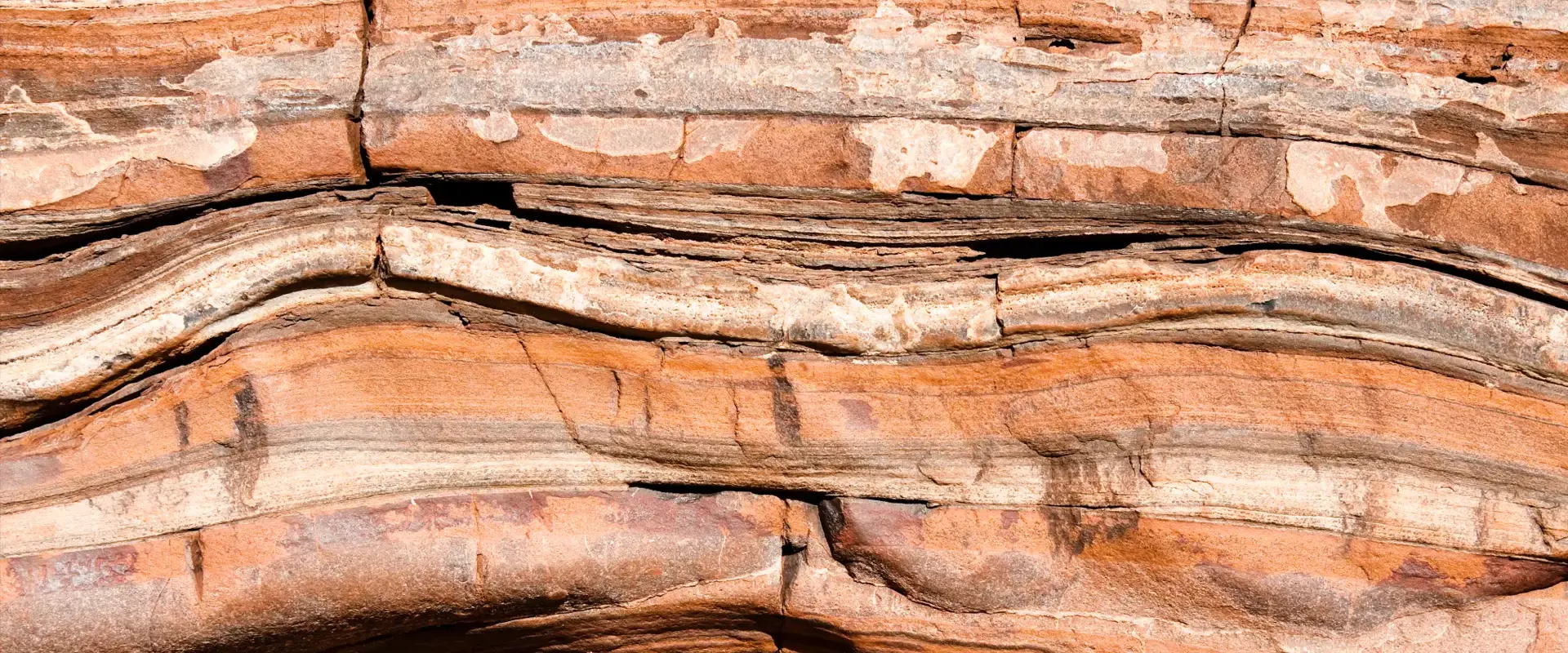
Lulworth and the Wessex Basin

Lulworth Crumple: © Mark Godden
Chalk cliffs are evocative of the south coast of England. For the most part their beds are gently dipping, indicative of an apparently quiet period in the tectonic history of the British Isles over the past eighty million years or so. But in Dorset the chalk rears up – standing on end to form a ridge extended westwards from Ballard Downs, under Corfe Castle and on to Lulworth Cove. This is the Purbeck Monocline (monocline: a bend in rock strata within in otherwise horizontal or gently dipping sequence).
 |
|
| Lulworth Cove © Mike Searle |
Lulworth Cove owes its form to the tectonic upheavals that produced the Purbeck Monocline. The chalk forms the back wall with the outer headlands of Portland Stone (Jurassic limestones) steeply inclined inland. Collectively these beds of the Purbeck Monocline form the northern limb of a vast anticline, the crest of which has been eroded out in Lyme Bay. The much-photographed tiny folds in Stair Hole also relate to this folding.
Many accounts refer to the Purbeck Monocline as ‘Alpine’, implying that the folds are the outer ripples of deformation emanating from the far corner of France. But this is rather misleading – there’s nothing much in the way of folding across the rest of France! The structural geology of Dorset relates to a process called tectonic inversion. Part of the Wessex Basin, containing several kilometres’ thickness of accumulated Jurassic strata, has been pushed up – and the Purbeck Fault, which bounds the basin, has been reactivated as a thrust. But why?
 |
|
| Geology of Lulworth: © British Geological Survey, NERC |
All of NW Europe is in the grip of tectonic compression – bound between the spreading mid-Atlantic ridge and Africa converging with Europe in the south. The effect has been to squeeze the sedimentary basins around Britain and Ireland, and some of the existing faults in these basins have reactivated as thrusts. This is what happened to the Purbeck Fault. Similar inversion structures are found under the southern North Sea where they host gas fields. Inversion of the Wessex Basin has been important for hydrocarbon geology too. Oil and gas originating in source rocks to the south of the Purbeck fault migrated out of these formations as a result of the inversion and fault reactivation – and some of it was trapped in the rocks ahead of the Purbeck monocline. The result is NW Europe’s biggest onshore oil field, Wytch Farm, together with its satellite oil fields at Kimmeridge and Wareham.
Podcast: Listen to Nicky White of the University of Cambridge explaining the tectonic processes that created the Lulworth crumple
Further reading:
Geological Society 100 Great Geosites - Lulworth
UNDERHILL,J. R. & STONELEY,R. 1998. Introduction to the development, evolution and petroleum geology of the Wessex Basin. In: UNDERHILL,J. R. (ed.) Development, Evolution and Petroleum Geology of the Wessex Basin, Geological Society, London, Special Publications, 133, 1-1
Twinned with: Alpine Deformation, Albania
The edge of the great Alpine mountain ranges form sweeping arcs through the Mediterranean region and on into the Middle East. One of these runs down the eastern coast of the Adriatic forming ranges of limestone hills – brought up in a series of long folds (anticlines). The limestones were deposited ...continue reading
Other sites
- Twin: Windward Isles
Cwm Idwal
- Twin: Mount Pinatubo
Sperrin Mountains
- Twin: Sierra Nevada
Southern Uplands
- Twin: Nankai
Ben Arnaboll
- Twin: Glarus Thrust
Outer Isles
- Twin: Tohoku Earthquake
Clogherhead and Shannon
- Twin: Papua New Guinea
Cairngorms
- Twin: New Hampshire Granites
Great Glen Fault
- Twin: North Anatolian Fault
The Lizard
- Twin: Troodos Ophiolite
Yoredales
- Twin: Antarctica
Stanage Edge
- Twin: Ganges Delta
Hartland Quay
- Twin: Zagros Range
Amroth-Saundersfoot-Tenby
- Twin: Salt Range, Pakistan
Vale of Eden
- Twin: East African Rift Valley
Zechstein
- Twin: Sicily
Alderley Edge
- Twin: Navajo Sandstone
Isle of Skye
- Twin: Mount Kilimanjaro
Lulworth Cove
- Twin: Albania
Giant's Causeway
- Twin: Cascade du Ray Pic
